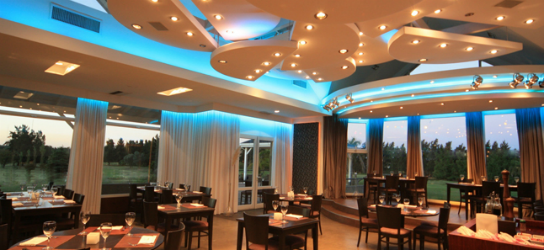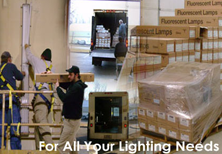Lighting Application Series: Smart Hospitality Lighting
For this week’s post in our ongoing Lighting Application Series, we’re tackling the hospitality industry — a business where customer impressions and satisfaction are everything. Top notch service and amenities are generally viewed as the key to the customers’ hearts, but neither of those things is possible without smart hospitality lighting. With that in mind, here are some lighting ideas for your hotel, restaurant, bar, or conference center.

Tips for Intelligent Hospitality Lighting
One of the most important things to remember when choosing your business’ lighting layout is that every “zone” of the building has different lighting needs. The type of lights and setup you use in the lobby may not be ideal in other areas, such as guest rooms. Here are some suggestions on how to optimize the lighting throughout the main areas of the building.
1. Reception and Lobby
The reception and lobby area is the guests first experience with your business, which means you need to design this space with the goal of making a good first impression. Lighting is well known to evoke a variety of moods, so select a light level and aesthetic that suits the mood your brand wants to convey. Also, because this can be a crowded area, illuminate important places, like the reception desk, and strategically place fixtures to naturally guide visitors in the appropriate directions.
2. Hallways
Long, poorly-lit hallways can make guests feel uncomfortable or closed in, and they detract from the secure atmosphere most people hope to find when at a hotel or other hospitality venue. However, even without natural daylight, you can make corridors brighter, safer, and add visual interest by upgrading to higher quality illumination and adding accent lights over art work, plants, and other décor.
3. Guest Rooms
As anyone in the hospitality industry knows, every customer is unique and has individual needs, and this holds true even when it comes to their lighting preferences. So, to accommodate the expectations of all customers, consider including a variety of lighting options in the guest rooms. For instance, by having a combination of overhead lights, lamps, and task lighting, guests can choose how to best illuminate their rooms. Also, by installing dimmers and other controls, they have the power to adjust light levels from day to night. These personal touches are the types of things that make an impact and encourage repeat customers.
4. Restaurants, Bars, and Lounges
Restaurants must provide a range of moods throughout the day, as they cater to breakfast, lunch, and dinner crowds. So, consider changing the lighting at each meal time to create the right ambiance for the different groups. For example, bright, cheery lights might work well for morning diners, but dimmer, more relaxing light is best suited for evening hours.
Although bars and lounges usually keep lower ambient light at all hours, having the option for full illumination is useful if the room is used for a different event and for cleaning or maintenance purposes.
5. Conference and Meeting Rooms
Providing a space where people can work efficiently and comfortably is crucial for getting repeat business visitors. As with guest rooms, provide a combination of lighting options, such as natural, adjustable ambient, and task lighting. Include dimmers and other controls — especially if the room is a multipurpose area which might also serve as a dance hall or gala location.
6. Outdoor Areas
The lighting outside your building gives passersby an immediate impression of your brand and lets them know what to expect from your business. Whether you want to establish a subtle, romantic appeal or a bright, Vegas-esque vibe, lighting can help you connect with your target market.
Additionally, for safety’s sake, don’t forget to properly illuminate parking lots, sidewalks, and garages.
Efficient Hospitality Lighting
In recent years, LED lighting has opened a whole new world in efficient hospitality lighting, as incadecent bulbs, halogens, and even CFLs are being replaced with modern LEDs. Here’s why:
Energy savings – LEDs are more efficient than any bulb on the market. Even while delivering the same number of lumens, they use only a fraction of the watts used by incandescents.
Money savings – Not only do LEDs reduce energy costs, they also have longer lives (i.e. less maintenance), and produce less heat (lower HVAC bills). It’s not uncommon for larger hotels to save 8 million kWh or more per year after switching to LEDs.
Increases revenue – Setting the right lighting environment for your guests leads to happy customers and repeat business.
Better quality – Today’s LEDs emit white, natural light with equal or improved coloring than traditional bulbs.
Versatile – LEDs work beautifully in everything from overhead fixtures, to accent lighting, and even candelabras. With their small size and flexibility, there’s virtually nowhere they can’t fit.
Easy retrofits – LEDs aren’t only for new buildings, they are also easily retrofitted into existing fixtures. In some cases, rewiring isn’t even necessary.
Conclusion
Whether your guest are working, relaxing, dining, or celebrating, use intelligent hospitality lighting to create the perfect mood and an experience customers won’ t soon forget. This means using a variety of lights throughout the property, integrating controls, and giving guests the power to optimize light levels in their personal spaces. And by adopting LED technology, you can better satisfy visitors while simultaneously saving energy and money.



No comments yet.